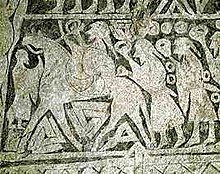Valknut
Appearance

- For other uses, see Valknut (disambiguation)
The valknut (Old Norse valr, slain warriors + knut, knot) is a symbol consisting of three interlocked triangles.
It is also called:
It appears on Scandinavian image stones in connection with Odin, e.g. on the 7th century Tängelgarda stone from Gotland.
According to H. R. Ellis Davidson (p. 146), the valknut —
- is thought to symbolize the power of the god [Odin] to bind or unbind [a man's mind] ... so that men became helpless in battle, and he could also loosen the tensions of fear and strain by his gifts of battle-madness, intoxication, and inspiration.
Geometrically, it is topologically equivalent to the Borromean rings, a closed 3-link chain, or the triquetra, depending on the particular artistic depiction:
-
The Valknut as Borromean rings
-
The Valknut as closed 3-link chain (modern only?)
-
The Valknut as triquetra
Paganism
The valknut symbol plays a role in modern heathen faiths drawn from Norse mythology, particularly Asatru, where it is sometimes said to represent the nine worlds. [1]
References
- Davidson, Hilda Roderick Ellis. "Gods and Myths of Northern Europe." Baltimore: Penguin Books, 1964. ISBN 0-14-020670-1
- Cromwell, Peter. Letter to the Editor: "Borromean Triangles in Viking Art." 17 Mathematical Intelligencer, pp. 3-4, 1995.link



